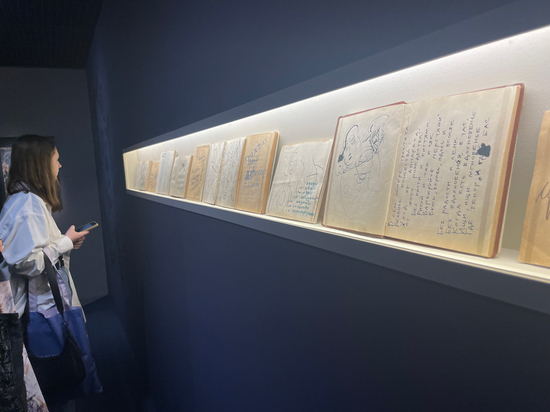For the first time, digitized treatises by Anatoly Zverev were shown to the public
[ad_1]

Dialogue with Leonardo da Vinci twisted into an atom
Renaissance man – this expression can equally be attributed to the great Leonardo da Vinci and the Soviet genius Anatoly Zverev. The era of the Thaw, which saw the heyday of Zverev’s expressive gift, is not for nothing called the Soviet Renaissance. Just then, the artist first became acquainted with the works of the Italian, began to write his own treatises and named Leonardo as his teacher in his autobiography. For the first time, Zverev’s manuscripts were digitized and not only presented in an electronic library, but also turned into an installation resembling an atom flying in space or a whole Universe of words and thoughts.
The exhibition “My Teacher Leonardo” at the Zverev Museum occupied three floors, each of which in its own way reveals the connection between two artists from different eras. On the first floor, the audience is greeted by graphics filled with amazing cinematography. Zverev worked phenomenally quickly – he made accurate, lively sketches in a matter of seconds. Among the unique exhibits of the graphic section are images of his wife Lucy, daughter Vera and a general family portrait. The last of these drawings is shown for the first time. The little daughter of the Zverevs is depicted on it many times, and it seems that we see how she rushes around her father and mother. Similar “storyboards” can be found in the works of Leonardo da Vinci – the Italian often made “live” sketches in the margins, illustrating his ideas.
A similar cinematography is present in other Zverev series, for example, in the famous cycle made at the Moscow Zoo. Animals are captured in motion – easily, expressively, accurately. There is all this in the painting, presented already on the second floor. There are many female portraits and landscapes. Of particular interest are the paintings made in Sokolniki, where the artist lived with his family in the late 1950s and early 1960s. He said that he knew by sight every tree there. The exhibition presents for the first time a painting from 1957 depicting the artist’s house. This is a two-story hut with dirty pink walls, in front of which drying clothes are hung on clotheslines. Here, in one of the modest rooms, Zverev lived with his wife, the athlete Lucy. True, not for long: when his daughter was three years old, he left the family. This page of his life is of particular interest to researchers, because it was then that Zverev the artist was born, who years later will be called a genius.
There is a legend that Zverev forced Lucy to tie a pillow to her head before going outside: the wife of a great artist should not fall and accidentally break her head. Already in his youth, with his characteristic impudence, he felt an ebullient talent in himself. And Zverev also taught his wife to draw and made him repeatedly copy the surrounding objects – for example, a teapot. Lucy copied regularly and also became an artist a little, but they did not have a quiet family life. Zverev was free by nature – in painting and in everyday life. Often over the edge. Later, he met a woman who understood and accepted his free spirit, Oksana Aseeva became her. Through the widow of the poet Nikolai Aseev, who was friends with many stars of the Silver Age, Zverev, as it were, conducted a dialogue with the geniuses of the past. But this conversation began with the great predecessors just with Leonardo da Vinci.
Zverev got acquainted with the works of the Italian when he was about 30 years old. This happened thanks to Alexander Rumnev, a theater and film actor, the premiere of the Tairov Chamber Theater (he brilliantly plays the Minister of Ballroom Dances, the Marquis of Pas de Trois in the famous black-and-white film Cinderella 1947 with Faina Ranevskaya). Rumnev took care of Zverev until his death in 1965. It was he who gave the young artist a two-volume collection of selected works by Leonardo da Vinci, published in the USSR in 1935. Zverev read it carefully and decided to write too. Many notebooks with the reasoning and memoirs of the Soviet artist have been preserved – some are written in even block letters, others – in a fluent sweeping handwriting. Notebooks, in natural and digitized form, can be found on the third floor of the museum – in the library room. Its center features an installation by contemporary artist Aristarkh Chernyshev. It consists, in fact, of Zverev’s texts, depicted on long ribbons-manuscripts, which are woven into circles and turn into a microcosm. The art object called “Zverev’s Universe” looks like an atom and a whole galaxy at the same time. “My work is a star system assembled from the artist’s treatises, this is one of the star systems in the Zverev Universe,” explains Aristarkh Chernyshev. Among the texts, you can also find a direct dialogue between the Soviet artist and the great Italian, and next to it is a sketch – two geniuses look into each other’s eyes.
Zverev chose Leonardo da Vinci as a teacher and had a dialogue with him all his life, did not argue and did not echo the great master of the Renaissance, but continued his thoughts. However, the Russian author often joked about this topic. “The student who has not surpassed the teacher is bad. I shed a tear and surpassed Leonardo, ”Zverev ironically. At the exhibition, which comprehends this creative connection through the centuries, we, the viewers, are invited to read it not only in graphics, painting and texts, but also through a “dialog box” flying in space, designed by the artist of the next generation.
[ad_2]
Source link






